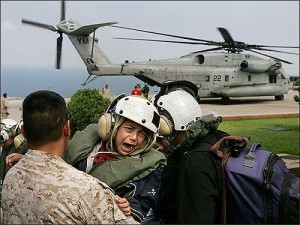 Had a chance to correspond with Time Magazine’s Mark Thompson yesterday, chatting about–you guessed it–Korea NEO evacuation. Looks like General Sharp and I are at odds. The article carries a great title: Betting the Family on Korea. Here’s my bit:
Had a chance to correspond with Time Magazine’s Mark Thompson yesterday, chatting about–you guessed it–Korea NEO evacuation. Looks like General Sharp and I are at odds. The article carries a great title: Betting the Family on Korea. Here’s my bit:
In light of the increasing banging of Korean war drums, is it time to halt — and maybe reverse — the flow of U.S. dependents to Korea? “Given the circumstances, accompanied Korean tours need to end now,” argues Craig Hooper, a naval scholar in San Francisco. “Get the dependents out, and get ’em out today. In Korea, full-bore modern conflict is always just a few artillery shots away.”
But Sharp, the U.S. commander, disagrees. “There is no reason that families should not be together here in Korea, one of the world’s most vibrant and dynamic societies,” he said Dec. 15. “Ultimately, the ROK-U.S. Alliance is a relationship between two peoples and by bringing more families to Korea I believe we will build stronger bonds between our countries.”
Sharp has championed a plan to build more housing, schools and other facilities so that all 14,000 married troops will be able to bring their families with them to South Korea for three-year tours by 2020. He likes the stability and reduced stress offered by longer, accompanied tours and their resulting greatly-reduced training requirements.
But the U.S. military has always been concerned about its ability to evacuate families if war breaks out. That’s why it’s moving Army units to a major post south of Seoul — away from North Korean artillery tubes — and close to a major transportation hub. It drills for such an eventuality twice a year, down to planning for what to bring (“3 days food/water”), what to do about pets (“pets are considered family members…pets cannot be abandoned”) and gas masks for adults, kids and infants.
But Hooper isn’t impressed. “Noncombatant evacuation plans are, at this point, unrealistic, underfunded and under-resourced,” he maintains. “Given North Korea’s propensity for chemical, biological and nuclear weaponry, America — and the rest of the region — is unprepared to handle wounded, contaminated, and possibly infectious refugees.”
I think we are underestimating the complexity of getting civilian non-combatants out of Korea. I will bet serious money that the NEO evacuation plans (such as they are) are based on some really rosy assumptions (fantastic weather, lots of warning, total order in the South, minimal casualties, little behind-the-lines disruption, etc). I suspect that everything looks great to, say, General Sharp and the rest of the officers–who probably are enjoying “normalized” tours already–but that the evacuation plans suffer real weaknesses waaay down in the lower-level operational nitty-gritty.
I’ve seen too many contingency plans that look great from afar, but quickly come apart after a cursory glance at the operational complexities. Find me a few Paul Van Riper equivalents and we’ll build a better NEO evacuation plan.
We’d probably start by asking that the MSC order a few of these useful civil-spec LCS-like sea-frames.

{ 2 comments… read them below or add one }
Hi Leesea–
We can charter, but that’s a business strategy…When the stuff really starts hitting the fan, every local asset will be put under charter–and the rates will be extraordinary. I’d far rather see some platforms–the HSVs, the WestPac express–heck, even that big trimaran that Austal has been trying to sell for the past year an a half–ready to roll out and ship NEOs to safety. (While bringing some guys and stuff to the fight.)
I’d sure like to know why the HSV ferries are not getting used someplace. Any ideas/thoughts/rumint?
Agreed that NEO plans need to be dusted off and assets placed against needs, but..
Why order new builds when MSC can rapidly charter almost any ship needed? I am sure there are many Japanese ferries (the likely destination) avaiable, a simple RFI can determine their availability.
The HSF WestPac Express can be used, but the HSV2 Swift needs to be repositioned to help. Not to mention that MARAD is still screwing around with its new HSFs. I have asked why those high speed ferries are not in naval service and get no good replies (like its all up to the lawyers).
I surely hope the USN does NOT plan on using amphibs for NEO since their capabilities will obviously be needed for other missions!